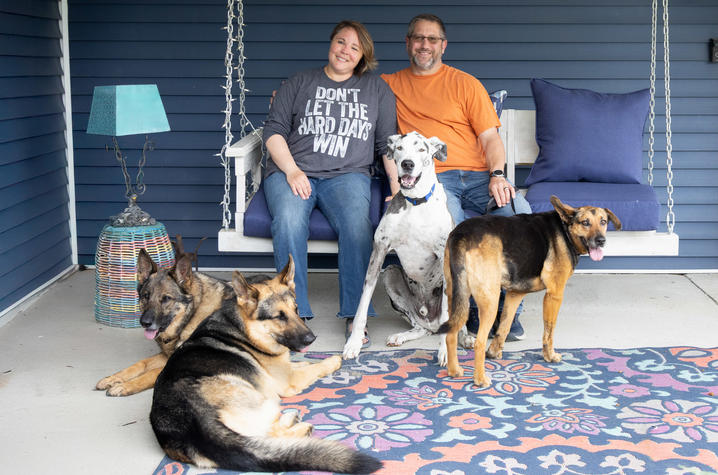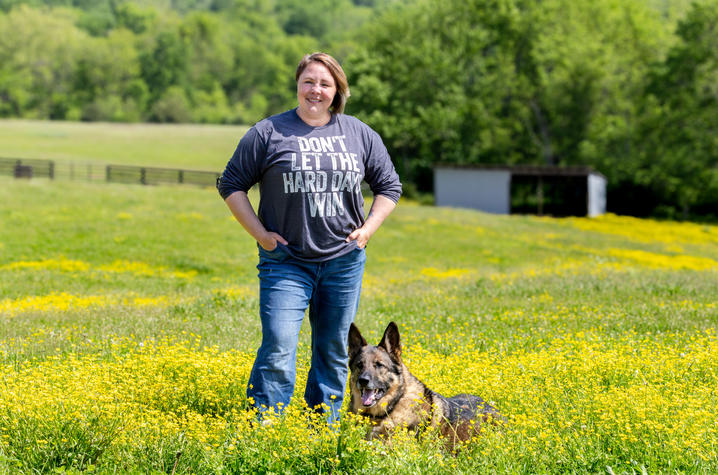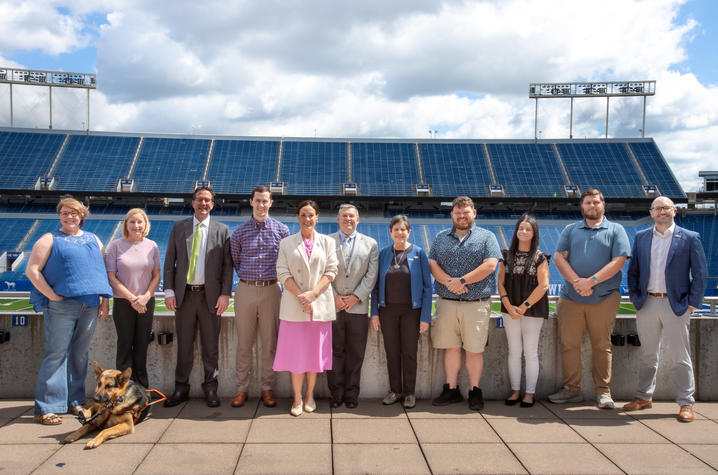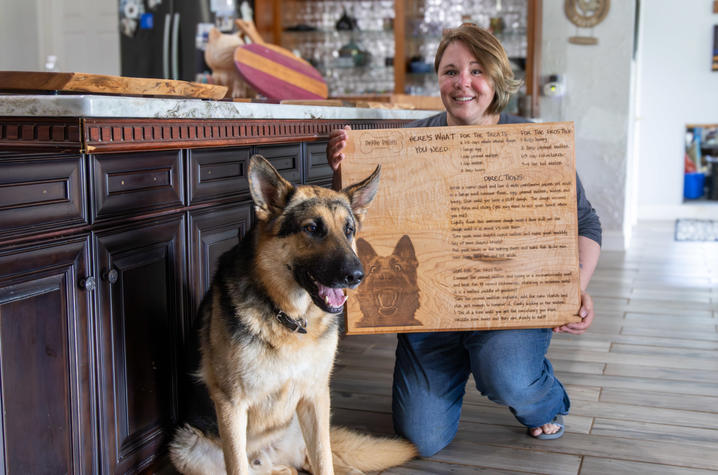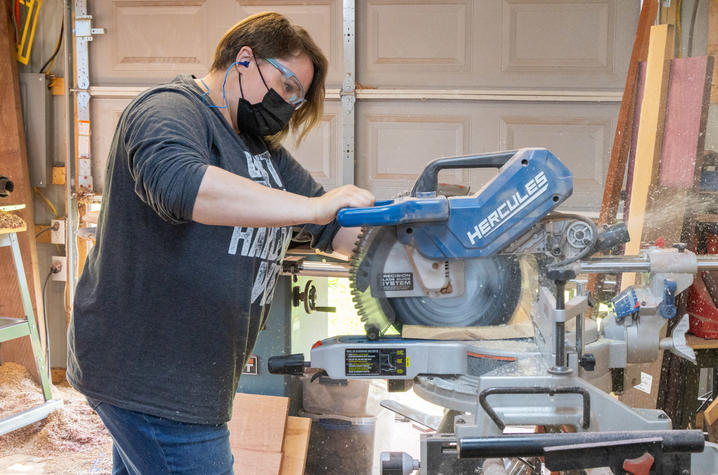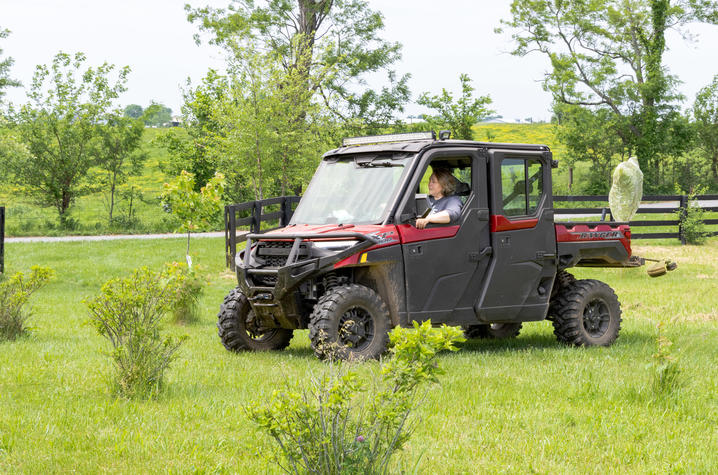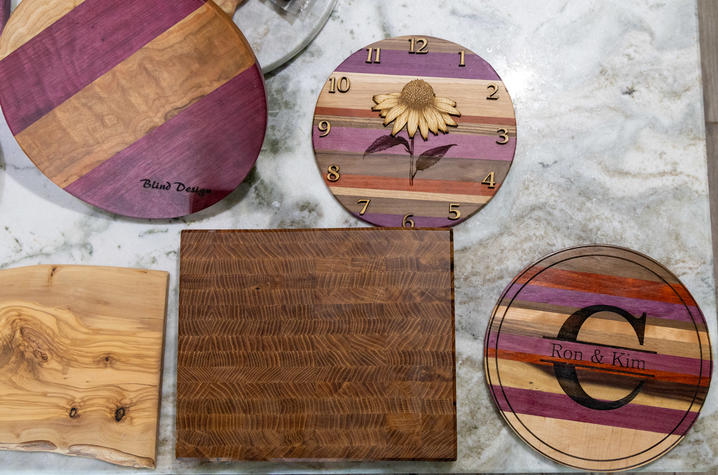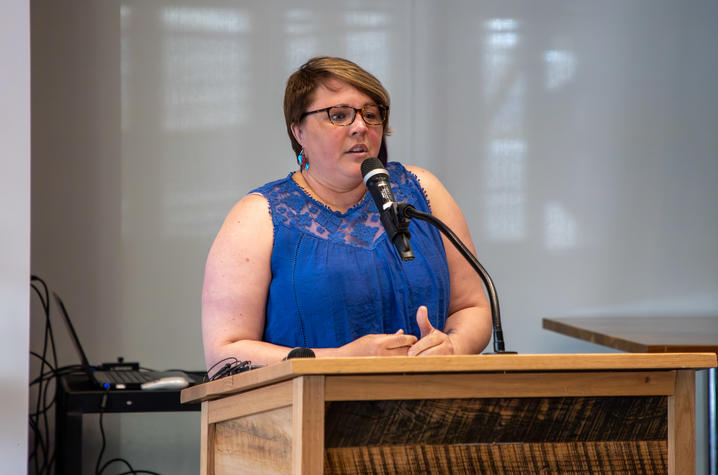Out of darkness, UK patient and trauma survivor finds her light
LEXINGTON, Ky. (May 22, 2025) — The countdown to wedding day was on. It was only a few weeks before Kati Rhea and her fiancé, Todd Kleinjan, were set to tie the knot on their farm in Harrodsburg, Kentucky. The couple was working on the property to make sure it was in perfect condition to host family and friends who would be traveling to celebrate their marriage.
On Aug. 9, 2017, Kleinjan was driving the side-by-side ATV while Rhea followed behind, spraying the briars and fence rows. Once they finished one section of land, they loaded up to move to the other side of the farm.
The two planned to move to the back part of the acreage and work their way back up to the front.
“Todd was driving quicker than he should’ve, but there was nothing reckless about it,” Rhea said. “And, unbeknownst to both of us at the time, we had a flat tire on the left side of the ATV.”
On their drive, there was a gopher hole that they couldn’t see.
“We hit the hole with our front left tire and because the tire was already flat, it took the tire off of the rim and the rim bit into the ground,” Rhea said. “The rim got stuck, drastically stopping our ATV, flipping us overhead.”
Kleinjan was ejected clear out of the ATV, but Rhea was thrown from the passenger side through the driver’s side door. When she hit the ground, the ATV followed, landing on top of her and the ATV’s roll bar crushed her face.
“It landed on me straight across where your glasses would sit on your face,” Rhea said. “So, the bridge of your nose across your eyes to your temples. I basically cushioned the blow for the ATV. I was stuck lying there under the ATV with my face smashed. So, Todd immediately went to get up to assess the situation and then realized that I was not in a good place.”
Kleinjan managed to get the ATV off Rhea and called 911 immediately. Since they were out on the back of the farm, an ambulance couldn’t reach them. Kleinjan had to figure out a way to get Rhea up to the road.
“He called the neighbor, and they put me in the bed of their pickup truck and drove me to the top of the road where the ambulance arrived,” Rhea said. “The ambulance medic took one look at me and called for a life flight helicopter because they didn’t think I was going to make it.”
Kleinjan suffered bruises and contusions all over his body, but received treatment and was released.
Rhea was airlifted to the Level 1 trauma center at the University of Kentucky Albert B. Chandler Hospital. Her entire face was smashed; it was described as looking like “pea gravel.” Her right eye was destroyed upon impact, and by the time she arrived at the hospital, she had also lost blood flow to her left eye.
“Kati sustained multiple facial fractures along with irreparable damage to her right eye and a left central artery occlusion that impacted her vision,” said Peter Timoney, M.D., director of oculofacial plastic/orbital surgery at UK Advanced Eye Care.
With her injuries, there was a chance she’d be completely blind. Considering the severity of the wreck, it was a miracle Rhea survived without severe brain damage.
“I thought I was going to have really severe brain damage just based on the way that my face looked and the fact that I was flat as a pancake,” Rhea said. “They said they could see part of my spinal area through where my nose should have been.”
Rhea did have some brain damage. Luckily, it wasn’t severe, though she initially had some trouble speaking.
“I did have trouble making sentences and everything was just really hard to put together,” she said. “But in general, I turned out way better than what they thought I was going to.”
Doctors thought Rhea was going to be completely blind. Her eyes were sewn shut; her right eye had to be removed. They thought there was no blood flow to her left eye and that the optic nerve had died.
But, even with her eyes sewn shut, Rhea kept seeing spots of light and color with her left eye.
“I just thought it was my head just messing with me. I thought it was a phantom,” Rhea said. “They got me up one day and we started walking down the hallway and I could see a little sliver of light. Once I told the rehab nurse what I thought I was seeing, they reevaluated me.”
It turned out that Rhea is part of a small percentage of people who have an extra blood vessel, called a cilioretinal artery. This blood vessel provides a different source of blood flow to the inside of the eye than usual. Somehow, even after the trauma to her face and eyes, this tiny artery survived.
The small artery allowed Rhea to keep a little bit of vision in her left eye.
“I only have roughly 1% vision in one eye,” Rhea said. “I tell people it’s like looking through a straw underwater and that’s my sight. That’s what I have left now.”
Over the last seven years since the accident, Rhea has had a long road to recovery. She’s had 42 facial surgeries, and it’s taken all this time to manage the pain she feels in her face on a daily basis. Severe trauma injuries like hers are not easy to bounce back from.
“My face was completely messed up, and I just wanted things to work and not be in pain,” Rhea said. “My face was crushed, it’s never going to be completely normal, but I wanted to at least be less scary and not have people stare at me so much.”
Aside from physical healing and facial reconstruction, Rhea also had to learn how to adjust to living with her new vision.
“It has been a great privilege to watch Kati learn to make the very most of the small area of vision that remains for her. Her positive spirit is incredible and lifts everyone she meets,” said Claire Fraser, M.D., UK Advanced Eye Care, associate professor of ophthalmology and visual sciences.
Rhea was a Lexington police officer for 16 years before the accident, but with her injuries, she couldn’t return to the job she loved.
“I’m not someone who can sit still,” Rhea said. “Once I was feeling good enough, I didn’t want to be sitting around. Everybody thinks that because I’m basically blind that I can’t do anything.”
Although her lack of vision could be challenging at times, she never considered it something that held her back. As soon as she was feeling well, she began relearning her routines and living life again with her new normal.
“I work taking care of the farm,” Rhea said. “We have 40 acres and about 100 animals. I drive the new ATV around the farm with my dog, and I work on the animals, feed, mow and lots of other things.”
During her time working on the farm, Rhea got the idea to start a new job venture: woodworking.
“I was drawn to it because I can only see certain colors,” said Rhea. “I can’t see a lot of colors, but with the few colors that I can see and using my touch, I fell in love with different types of wood. I could feel the type of wood by touching the grain. I could feel all these different things that I’ve never felt before with wood. It was a massive challenge, and it was something that I could do here on the farm.”
She decided to start her own woodworking business called Blind Design. Rhea uses her talent to build tables and create charcuterie boards, cutting boards, custom farm signs and other custom wood designs.
“Some people see me as damaged goods and not worth anybody’s time, but I’m not a person who accepts that,” Rhea said. “I prove those people wrong.”
Rhea has continued to prove people wrong and inspire those around her including her care team.
“Katie has been an inspiration to me as she has defined positivity and enthusiasm in every step of her recovery,” Timoney said. “She continues to strive to fulfill and complete her life goals on a daily basis.”
Honoring trauma survivors
Each year on the third Monday in May, the UK Trauma Department celebrates National Trauma Survivors Day. It’s a day to celebrate the resilience and strength of trauma survivors, along with their families, friends and the professionals who support them.
“It is important for the UKHealthCare Trauma Program to recognize this day and celebrate our trauma survivors,” said Amie Peel, a registered nurse and UK Trauma’s outreach and education coordinator. “It’s a time to recognize and validate our survivors of traumatic injuries and the long, difficult journey through recovery. We acknowledge their strength and resilience, raise awareness and sense of community. It’s also a time for us to honor our healthcare professionals and create support for the trauma system.”
This year, UK’s trauma survivors and their loved ones were invited to a celebration in the Longship Club at Kroger Field. Rhea was one of the survivors selected to share her testimony at the event.
“Telling one’s story can be a powerful part of the healing process, allowing them to see how far they have come,” Peel said. “Survivors can inspire and support others, offering hope and encouragement, and helping reduce feelings of isolation that other survivors may be struggling with. UK HealthCare is proud to give our survivors a platform and honor their resilience and strength.”
For Rhea, sharing her testimony was a time for her to reflect on her seven-year journey, inspire others to keep living life to the fullest and give thanks to the team of health care providers who saved her life.
“I spent two months receiving treatment from UK,” Rhea said. “I shouldn’t be alive, but here I am. I wouldn’t be here without the team that worked around the clock for me.”
The UK Trauma Program plans to continue celebrating its survivors for years to come, to support all their patients’ recovery journeys.
“Each year, the family grows, and to see previous years’ survivors return and support each other is motivating,” Peel said. “This celebration is a reminder that recovery is possible, even after the darkest and most difficult times. This event is a powerful reflection of human strength, community and hope. There is a unique bond among trauma survivors and their families, a bond that only they can understand; a shared accomplishment.”
UK HealthCare is the hospitals and clinics of the University of Kentucky. But it is so much more. It is more than 10,000 dedicated health care professionals committed to providing advanced subspecialty care for the most critically injured and ill patients from the Commonwealth and beyond. It also is the home of the state’s only National Cancer Institute (NCI)-designated Comprehensive Cancer Center, a Level IV Neonatal Intensive Care Unit that cares for the tiniest and sickest newborns and the region’s only Level 1 trauma center.
As an academic research institution, we are continuously pursuing the next generation of cures, treatments, protocols and policies. Our discoveries have the potential to change what’s medically possible within our lifetimes. Our educators and thought leaders are transforming the health care landscape as our six health professions colleges teach the next generation of doctors, nurses, pharmacists and other health care professionals, spreading the highest standards of care. UK HealthCare is the power of advanced medicine committed to creating a healthier Kentucky, now and for generations to come.





